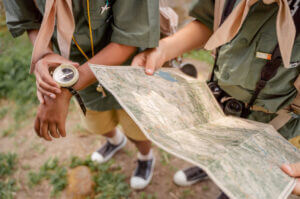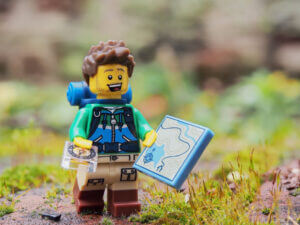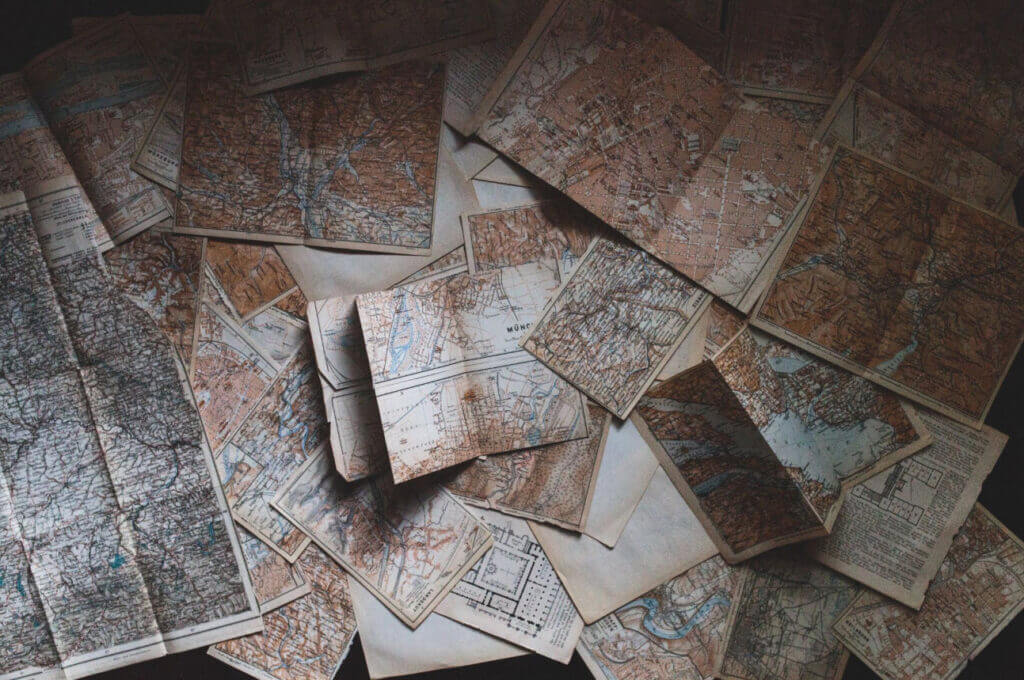Learning and Mastering The Art of Local Navigation without GPS

You and your family all need to know the skill of navigation using a number of different methods, both with and without gadgets to help you. Navigation also needs to be learned for different times of the day and seasons, as well.
If you’re in an area where snow covers the landscape, and you’d practiced during the summer how to navigate according to landmarks that are now covered, you’d be lost quickly.
GPS may be limited if the grid goes down. And even now, maps can become outdated and lead you into dangerous situations. Therefore, you never want to exclusively rely on digital maps for your safety and survival.
Navigational Tools That Can Help You Find Your Way
While digital GPS might be working if the grid is up, it may not always be accessible. And when it isn’t, you need a backup form of help to get you from one place to another. There are tools you can use that don’t rely on satellites.
The first thing you want to do is invest in some maps. Not one copy, but a copy for each member of your family. You don’t just want a highway map, either. There may be circumstances in a survival event when you need to avoid major roadways.
But get one of those, plus topographical maps and any other maps for your geographic location, like national park maps. You’ll want to laminate them to protect them from wear and tear as well as water damage.
Teach yourself and loved ones how to read a map, using the legend and symbols and show them how the scale of measurements work. You may not even be on land, because in some instances, you’ll be using a boat or be on a ship during a survival event.
Depending on where you live and what your circumstances are having a nautical chart might be beneficial to you as well, because you never know what type of transport you’ll be using to escape something or travel to a new destination that can provide safety for your family.
In addition to maps and charts, a good, old-fashioned compass will be a lifesaver in a survival event. You want to get one for everyone to have in their bug out bag. This will help you find a magnetic North position and this can be used anywhere, in any weather or location.
Navigation Using Sky and Land Techniques
But what if you don’t have anything on hand to help you navigate? You are stuck without a map or compass, and the grid is down so your GPS isn’t working. How would you navigate then?
It’s important to learn how to use both land and sky techniques to find your way without problems. This is how our ancestors roamed the Earth, and you can guide yourself in the same manner.
Let’s start with the sun. This is something that most people know how to do at least minimally. If you look outside during the morning or evening hours, you’ll know that the sun rises in the east and sets in the west, so that gives you a bit of navigational power.
But what if it’s nighttime and you can’t use the sun? Assuming it’s not cloudy, you can use the stars to navigate by. You can look up and find the North Star to help guide you. Most people can spot the Big Dipper constellation, and this shows you the North Star (which is the last star in the Little Dipper handle).
Of course, these are based on the Northern Hemisphere. There are other instructions for the Southern Hemisphere, but the same principles apply in using the sky during the day or night to find your way around.
You might have weather that prevents you from adequately using the sky for navigational purposes. If that’s the case, you can still find your way by using landscape to give you clues on where you’re at and where you’re going.
If you find a river, for example, you can follow it downstream to a lower elevation where you may find a town and a larger body of water. If you take time to learn the geography in your surround location, you’ll be able to recognize things like a mountain range and find your way according to that.

Sometimes you’ll spot moss growing on trees, and this is something that can help you navigate because moss mainly grows on the north side of a tree, where it’s more shady and damp.
Learn and Practice Safe Ways to Master Navigation With Your Family
Navigational mastery is not something where you simply dole out the compass and maps and assume everyone can make do with those supplies. You have to educate every member of your family about how to use them or how to work without them.
Practice is essential, and that practice needs to take place regularly, not just one time. You need to practice during the day, at night and in different weather conditions and locations.

Try starting out from home, then go elsewhere and get dropped off so you can navigate home. Go out in the wilderness and even get on a boat to try nautical navigation a few times.
You can go on hikes and outings with groups where you not only learn navigation, but also foraging efforts simultaneously. Look for a guided survival event like this or hire an individual to show your family the ropes, instead.
You also need to know what to do if and when you find yourself lost. Even practiced navigational experts can find themselves in a situation where they’re a bit disoriented and if this happens, you have to be able to not panic and assess where you’re at and where you need to go.
You want to have some steps in place for what you’ll do to figure out your next steps. Panicking and running in the wrong direction could put you in grave danger. Start by using any tools you have.
If it’s a compass or map, check to see if those will assist you in that moment. Some people have had trouble with a compass functioning properly near electrical or metal items, so that may not be operational.
If you don’t have those on hand, look to the sky and land to find your bearings. Look for the sun, stars, water sources, plants that give tell-tale signs of which direction is which, and more.
If you have an analog watch with you, there is another and somewhat more reliable method, at least if it’s daytime and the sun is visible above the horizon. Lay the watch flat, and rotate it until the hour hand is lined up with the sun, along a straight line of sight. The hour hand will form an angle with the number 12 on the dial. Divide the angle in half, and you’ll have a line bisecting the dial – the end between the hour and and 12:00 is pointing South, and the other end is pointing North. Before noon, you measure clockwise from the hour hand, and after noon, counterclockwise. Remember, if your watch is set to Daylight Saving Time, you’ll need to adjust the method accordingly (you can either set the hour hand back one hour, or just use the 1:00 mark instead of the 12:00 mark).
The principle is the same if you’re in the Southern Hemisphere, but slightly different. If you’re south of the Equator, the Sun is in the northern part of the sky. You hold your watch horizontally, and align the 12:00 marker with the Sun. North, not South, will be at the halfway point between the hour hand and the 12:00 mark.
Keep in mind there are various products you can buy for navigation. A compass doesn’t have to be separately carried in a backpack. You can buy watches that have a built-in compass so that you have it at all times. Some survival knives have a compass built in as well.
So now you know about navigating without GPS it is time to go to our next report, Number 19: Why You Need to How to Master the Art of Being a Grey Man.
If you missed the previous article, you can click on the link and check it out here: Part 17: Why You Need to Take Some Self Defense Precautions


